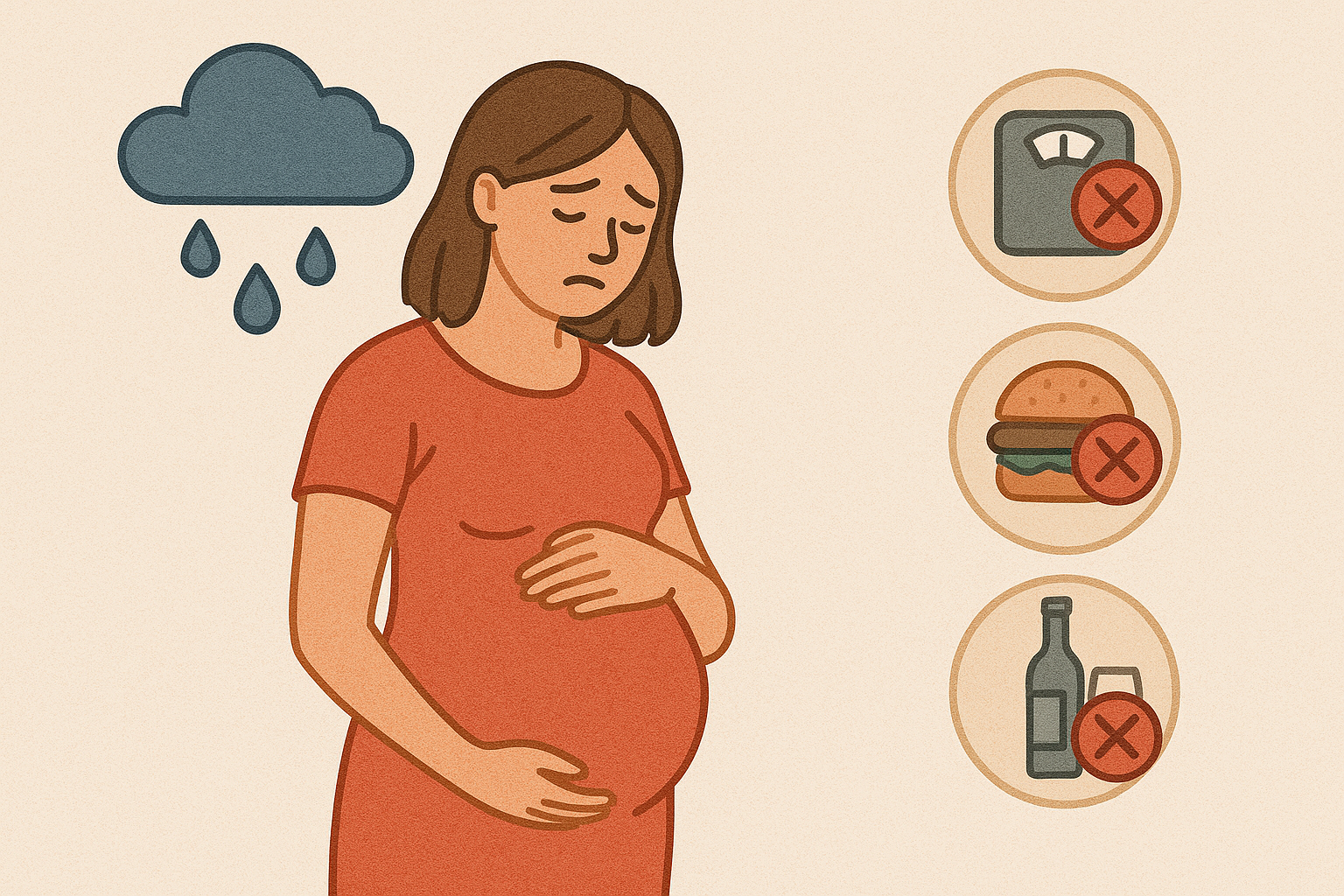RISK FACTORS ASSOCIATED WITH CHRONIC ENERGY DEFICIENCY (CED) IN PREGNANT WOMEN

Downloads
Background: Chronic Energy Deficiency is a nutritional problem in pregnancy. The percentage of pregnant women with Chronic Energy Deficiency is the 5th highest among Puskesmas Basarang due to the consequences caused by Chronic Energy Deficiency in Puskesmas Basarang from 2023 to August high in Puskesmas Basarang as much as 22.90%. The study purposed to find out the relationship between maternal knowledge about nutrition, husband's support, family income, maternal age, and pregnancy distance with the incidence of CED in pregnant women in the working area of Puskesmas Basarang, Kapuas Regency in 2023. Method: The research was analytical observational with a cross sectional approach, the sample was 66 pregnant women in the Basarang Community Health Center Working Area, Kapuas Regency, taken using the total sampling technique. The research instrument used a questionnaire. Result: The results of the multivariate test of the variabel of maternal knowledge about nutrition were most associated with the incidence of CED in pregnant women (Exp(B) = 11.655). Conclusion: The most dominant variabel with the incidence of SEEK in pregnant women is maternal knowledge about nutrition.
Andini, F.R., 2020. Hubungan faktor sosio ekonomi dan usia kehamilan dengan kejadian kekurangan energi kronis pada ibu hamil di Puskesmas Prambontergayang Kabupaten Tuban. Amerta Nutrition, 4(3): 218.
Arifin, S. 2020. Peta teori Ilmu Kesehatan Masyarakat. Administrasi Kebijakan Kesehatan dan Perilaku Kesehatan. Penerbit Mitra Wacana Media: Bogor. Astuti, A.B., Santosa, S.W. and Utami, M.S., 2000. Hubungan antara dukungan keluarga dengan penyesuaian diri perempuan pada kehamilan pertama. Jurnal Psikologi, 27(2): 84-95.
Dinas kesehatan Kabupaten Kapuas Kalimantan Tengah. 2022. Pemantauan Wilayah Setempat KIA Desember 2021.
Diningsih, R., F., Puji, A., W., Erika, L. 2021. Hubungan Tingkat Pengetahuan Tentang Gizi Terhadap Kejadian Kekurangan Energi Kronik (KEK) Pada Ibu Hamil. Binawan Student Journal (BSJ), 3(3).
Erita, M., Amlah, & Rahmawati, E. 2023. Hubungan Paritas, Jarak Kehamilan dan Riwayat Penyakit dengan Kejadian Kekurangan Energi Kronik (KEK) pada Ibu Hamil di Wilayah Kerja Puskesmas Makrayu Palembang tahun 2022. Jurnal Ilmiah Obsgin, 209-218.
Fakhriyah, F., Noor, M.S.N., Setiawan, M.I., Putri, A.O., Lasari, H.H., Qadrinnisa, R., Ilham, M., Nur, S.Y.L.L.S., Zaliha, Z., Lestari, D. and Abdurrahman, M.H., Buku Ajar Kekurangan Energi Kronik (KEK). Yogyakarta: CV.Mine.
Fitri, N., L., Sari, A. A., Dewi, N. R., Ludiana, Hayati, N., 2022. Hubungan Usia Ibu Dengan Kejadian KEK Pada Ibu Hamil Di Puskesmas Ganjar Agung Kecamatan Metro Barat Kota Metro. Jurnal Wacana Kesehatan, 7(1).
Fitriani, Afriyani, L.D., Diba, F., Wahyuni, Y.I., Indriani, D., Wahyuni, T., dkk. 2021. Literature Review Hubungan Pengetahuan dengan KEK pada Wanita Prakonsepsi. Seminar Nasional Kebidanan: 196-204
Fransiska, Y., Murdiningsih, M., & Handayani, S. 2022. Faktor-Faktor yang Berhubungan dengan Kejadian Kurang Energi Kronis pada Ibu Hamil. Jurnal Ilmiah Universitas Batanghari Jambi, 22(2): 763. https://doi.org/10.33087/jiubj.v22i2.1817
Friedman, M.M., Bowden, V.R. and Jones, E.G., 2012. Buku Ajar Keperawatan Keluarga: Riset, Teori dan Praktek (Family Nursing: Research, Theory and Practice). edisi 5). Jakarta: EGC.
Green, Lawrence., 1980. Health Education Planning A Diagnostic Approach. Baltimore. The John Hopkins University, Mayfield Publishing Co.
Halimah. G.S., Jayanti, R.D., & Fatmaningrum, W. 2022. Hubungan Usia, Paritas, dan Pekerjaan Terhadap Resiko KEK Ibu Hamil Trimester 1 di Puskesmas Cilengkrang Bandung Tahun 2022. Jurnal Sehat Mandiri: 94-103.
Harlissa, R., Sugesti, R., & Darmi, S. 2023. Hubungan antara Dukungan Suami, Status Gizi, dan Anemia pada Ibu Hamil dengan Kejadian Bayi Baru Lahir Rendah di Puskesmas Toboali Kabupaten Bangka Selatan Tahun 2021. SIMFISIS Jurnal Kebidanan Indonesia: 381-387.
Hayat, F., Nurce A., Tria A. E. P., 2021 Peran Dukungan Suami Dan Faktor Lainnya Terhadap Pemanfaatan Pelayanan Gizi Oleh Ibu Hamil Dengan Risiko Kurang Energi Kronis (KEK). Jurnal Keperawatan Silampari, 5(1)
Kemenkes RI. 2021 Pedoman Pelaksanaan Teknis Surveilans Gizi. Jakarta Kemenkes RI. Laporan Kinerja Direktorat Jenderal Kesehatan
Kementerian Kesehatan Republik Indonesia. 2015. Pedoman penanggulangan Kurang Energi Kronik (KEK) pada ibu hamil. Jakarta: Ditjen Bina Gizi dan KIA Direktorat Bina Gizi.
Kurniawan, D.A.N., Triawanti, Noor, M.S., Djallalludin, & Qamariah, N. 2021. Literature Review: Hubungan Pekerjaan dan Penghasilan Keluarga dengan Kejadian Kurang Energi Kronik pada Ibu Hamil. Homeostatis: 115-126.
Lestari, D.S., Nasution, A.S. and Nauli, H.A., 2023. Faktor-Faktor yang Berhubungan dengan Kejadian Kurang Energi Kronik (KEK) pada Ibu Hamil di Wilayah Kerja Puskesmas Bogor Utara Tahun 2022. PROMOTOR, 6(3): 165-175.
Mansoben, N. and Gurning, M., 2022. Pengetahuan, Dukungan Suami Dan Pendapatan Ekonomi Dengan Kejadian Kekurangan Energi Kronik Pada Ibu Hamil. Jurnal Keperawatan, 14(2): 401-408.
Marini, Solechah, S.A., Fathullah, D.M., Suryani, N., Yulidasari, F., Setiawan, M.I., & Rahayu, A. 2023. Hubungan Usia Ibu, Kadar Hemoglobin, dan Status KEK saat Kehamilan dengan Berat Badan Lahir Bayi. Ghidza : Jurnal Gizi dan Kesehatan: 296-304.
Marisi, T. 2021. Faktor-Faktor Yang Mempengaruhi Kejadian Anemia Pada Ibu Hamil Di Wilayah Kerja Puskesmas Kecamatan Kebon Jeruk Jakarta Barat. Jakarta: Universitas Binawan.
Notoatmodjo S. 2010. Ilmu Perilaku Kesehatan. Jakarta: Rineka Cipta.
Novitasari, Y.D., Wahyudi, F. and Nugraheni, A., 2019. faktor–faktor yang berhubungan dengan kekurangan energi kronik (KEK) ibu hamil di wilayah kerja Puskesmas Rowosari Semarang. Jurnal Kedokteran Diponegoro (Diponegoro Medical Journal), 8(1): 562-571.
Nugraha,R.N., Lalandos, J.L., & Nurina, Rr.L. 2019. Hubungan Jarak Kehamilan Dan Jumlah Paritas Dengan Kejadian Kurang Energi Kronik (Kek) Pada Ibu Hamil Di Kota Kupang. Cendana Medical Journal: 273-280.
Nur'aini, F., Avianty, I., & Prastia, T.N. (2021). Faktor- Faktor Yang Berhubungan Dengan Kejadian Kurang Energi Kronis (Kek) Pada Ibu Hamil Di Wilayah Kerja Puskesmas Tegal Gundil Bogor Tahun 2020. Promotor Jurnal Mahasiswa Kesehatan Masyarakat: 219-226
Paramashanti. 2019. Gizi Ibu dan Anak. Yogyakarta: Pustaka Baru
Permana, P & Wijaya, G.B.R. 2019. Analisis faktor risiko bayi Berat Badan Lahir Rendah (BBLR) di Unit Pelayanan Terpadu (UPT) Kesehatan Masyarakat (Kesmas) Gianyar I tahun 2016-2017. Intisari Sains Medis: 674-678.
Primadani, F.D., 2016. Faktor-Faktor Yang Mempengaruhi Kejadian Kek Pada Ibu Hamil Di Puskesmas Baturraden Ii Kabupaten Banyumas (Doctoral dissertation, Universitas Muhammadiyah Purwokerto).
Rahayu, T. D., & Sagita, D. Y. 2019. Pola Makan dan Pendapatan Keluarga dengan Kejadian Kekurangan Energi Kronik (KEK) pada ibu hamil Trimester II. Holistik Jurnal Kesehatan, 13(1).
Rohmah, L. 2020. Evaluasi Program Pemberian Makanan Tambahan (PMT) pada Ibu Hamil Kekurangan Energi Kronis (KEK) di Wilayah Kerja Puskesmas Karanganyar Kota Semarang. Semarang: Universitas Negeri Semarang.
Rudiyanti, N. & Rosmadewi. 2019. Hubungan Usia, Paritas, Pekerjaan Dan Stress Dengan Emesis Gravidarum Di Kota Bandar Lampung. Jurnal Ilmiah Keperawatan Sai Betik, 7-18.
Suryani, L., Riski, M., Sari, R.G. and Listiono, H., 2021. Faktor-faktor yang mempengaruhi terjadinya kekurangan energi kronik pada ibu hamil. Jurnal Ilmiah Universitas Batanghari Jambi, 21(1): 311-316
Teguh, N.A., Hapsari, A., Dewi, P.R.A. and Aryani, P., 2019. Faktor-faktor yang mempengaruhi kejadian kurang energi kronis (KEK) pada ibu hamil di wilayah kerja UPT Puskesmas I Pekutatan, Jembrana, Bali. Intisari Sains Medis, 10(3).
Vladimir, V. F. 2021. Pengendalian Kejadian Kekurangan Energi Kronis (Kek) Pada Masa Kehamilan Di Wilayah Kerja Puskesmas Rambah. Maternity and Neonatal, 09(69): 5–24.
Yuniar, A., K., B., Fatmawati, S., 2023. Gambaran Karakteristik Ibu Hamil Kekurangan Energi Kronik (KEK) Dan Dukungan Suami Di Wilayah Surakarta. Jurnal Imliah Ilmu Kesehatan, 1(4).
Yunita, N & Ariyati, M. 2021. Hubungan Pola Makan dan Pendapatan Keluarga dengan Kejadian Kekurangan Energi Kronis (KEK) pada Ibu Hamil di Wilayah Kerja Puskesmas Kertak Hanyar. Jurnal Kesehatan Indonesia: 100-106.
Copyright (c) 2025 Lowisa Kristina Hutapea, Meitria Syahadatina Noor , Edi Hartoyo , Triawanti Triawanti, Muhammad Abdan Sadiqi

This work is licensed under a Creative Commons Attribution-ShareAlike 4.0 International License.
1. The journal allows the author to hold the copyright of the article without restrictions.
2. The journal allows the author(s) to retain publishing rights without restrictions
3. The formal legal aspect of journal publication accessibility refers to Creative Commons Atribution-Share Alike 4.0 (CC BY-SA).
This Journal (e-ISSN 2656-7806) is licensed under a Creative Commons Attribution-ShareAlike 4.0 International License.
















